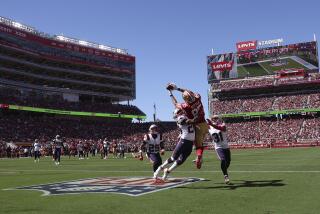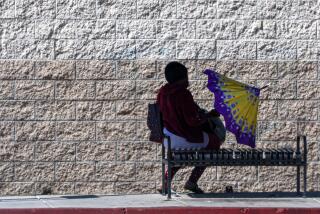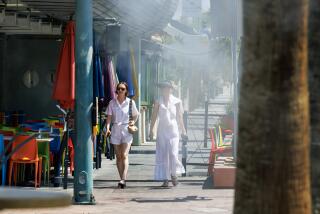Weather Watchers Keep an Eye Out for the Record
- Share via
Ask three people for the time and you’re bound to get three different answers.
So how can you be sure that reports of triple-digit temperatures shattering a heat record are really true?
Well, you just have to take the word of your faithful weather observer.
“If they say a record temperature was set for the date, you can trust that,” said Gary Ryan, a meteorologist who oversees the National Weather Service’s cooperative observers program.
“You have people who have been keeping records for 30 years,” he said. “These are very reliable people.”
Thousands of amateur meteorologists across the country help the National Weather Service make local forecasts and track long-term global weather patterns by performing a simple daily ritual: going out into their backyards to look at thermometers.
There are about 40 weather watchers in Los Angeles County, checking daily high and low temperatures from Torrance to Palmdale and calling in their findings to the weather service.
Although some weather wonks have sophisticated, computerized observation stations, most are uncompensated volunteers who stroll outside each day to check thermometers tucked inside birdhouse-style weather instrument shelters.
The observers then call in the day’s high and low temperatures to the National Weather Service, which processes the information and sends it to airports, news organizations and anyone else interested in weather data.
But how can the National Weather Service be sure it’s getting accurate reports? “All of the sites are inspected once a year,” Ryan said. “The weather instrument shelters must be 6 feet off the ground, properly ventilated and away from direct sunlight.”
Though it’s important that the equipment be in proper working order, Ryan said, it’s even more important that observers be consistent and accurate.
“We use their information for forecasts, climatology records, climate trends, rainfall data and flood forecasts,” Ryan said. “They are the heart and soul of the National Weather Service program.”
There are more modern alternatives. Tim Boyle, a weather observer at Cal State Northridge, uses computer technology to provide weather information to the National Weather Service and other agencies. Boyle tracks temperatures, wind speed, wind direction, humidity and barometric pressure, all without leaving his cubbyhole office. “The computer picks up weather events all the time and allows me to do deeper analysis of weather patterns,” he said.
But old-fashioned observations still have their place, he said. “We have to go outside to make sure that what the computer is telling us is correct.”
Temperatures are expected to range from the upper 90s to 105 degrees today through Sunday in Chatsworth, Van Nuys, Woodland Hills, Santa Clarita and Lancaster, said Kevin Stenson, a meteorologist for WeatherData Inc.
“We may get into more seasonable, cooler temperatures at the start of next week and continue through the middle of the week,” Stenson said. “After that, it’s a roll of the dice.”
More to Read
Sign up for Essential California
The most important California stories and recommendations in your inbox every morning.
You may occasionally receive promotional content from the Los Angeles Times.










